Jon
Admin 
Posts: 6,912
|
Post by Jon on Nov 27, 2014 23:21:34 GMT
Barty and I have been trying to help with Fleur's museum project and one thing we have tried to nail down is the history of Plainmoor. I'll post the latest drafts of a couple of pieces here.
The first is my "too much detail" history. The second is Barty's "executive summary" which may be more palatable to less obsessive readers.
Any amendments or additions will be gratefully received.
|
|
Jon
Admin 
Posts: 6,912
|
Post by Jon on Nov 27, 2014 23:23:02 GMT
Torquay Athletic first played at Plainmoor in 1881, but in a field on the other side of the road between Manor Road, Cary Park and Warbro Road. They moved across to what is now TUFC’s ground for the 1882/83 season.
Torquay Athletic folded at the end of the 1884/85 season but reformed for the 1886/87 season – the phoenix club also playing at Plainmoor. The Phoenix was effectively a merger of the Excelsior and Ellacombe clubs who also played at Plainmoor from 1884 to 1886.
Torquay Athletic had to leave Plainmoor at Christmas 1887 as the Cary Estate trustees planned to build houses on the field. Athletic played half a season at Shiphay before moving to the brand new Recreation Ground opened by the newly created Recreation Ground Company in 1888.
Disagreements over financial terms saw Athletic play the 1890/91 season at Paignton Cycle Track, return to the Rec for 1891/92 but then abandon the Rec again to return to Plainmoor for the 1892/93 season.
Before the 1892/93 season, Torquay Athletic constructed the first ever Plainmoor grandstand – 60 feet long with four tiers of seats and ample room for dressing rooms etc. underneath.
Athletic stayed at Plainmoor for twelve seasons gradually making improvements to the ground. There were two pitches at the time – the second one behind the Ellacombe end. Amongst the teams that played on the second pitch from around 1901 was Ellacombe Church Lads Brigade which evolved into Ellacombe AFC whose president was the Vicar of Ellacombe, Reverend Percy Baker.
In 1899 Torquay United evolved from Torquay Public College FC and played the 1899/1900 season at Teignmouth Road – roughly where Stantaway Hill now stands.
In 1900 the Recreation Ground Company was liquidated – the root of its financial problems being the fallouts with Torquay Athletic. Torquay United leased the Recreation Ground from the liquidator from the start of the 1900/01 season. In 1902, Torquay Town Council took over the Rec from the liquidator and continued to lease it to Torquay United.
In the summer of 1903, the Cary Estate gave Torquay Athletic twelve months’ notice as again they intended to build at Plainmoor. Torquay Athletic applied to take over the Rec from Torquay United and after much heated debate, the council agreed that Athletic would lease the Rec from the 1904/05 season. They have stayed there ever since – despite several attempts over the years by Torquay United to win the ground back for soccer.
Homeless Torquay United moved in to share with Torquay Cricket Club at Barton Road / Cricketfield Road (now Barton Cricket Club’s ground) for 1904/05. They moved to the other side of Cricketfield Road – where Parkhurst Road now stands – for 1905/06, but the stay was short-lived as the builders moved in and United moved back across the road to the lower portion of the cricket ground where they stayed for four years 1906 to 1910.
Meanwhile, the empty Plainmoor ground was let to the Reverend Baker on a temporary basis pending building work beginning. Baker then sublet the two pitches for various sports including to Ellacombe AFC who began to charge a “twopenny gate” from 1904.
The temporary arrangement lasted longer than expected. In 1909 Torquay Council wanted to buy both the football field and the adjoining Homelands field to build a new school and to retain the football field for sporting activity. However they would not meet the valuation put on the fields by the Cary Estate who could get a better price from house builders.
Reverend Baker came to the rescue by forming a group of local people who raised £500 to bridge the gap in value. Plainmoor thus came into council ownership in 1910 – with Homelands school to be built on the adjoining field.
In 1910 there was a movement to merge Torquay’s three biggest football clubs – Babbacombe, Ellacombe and Torquay United. The latter two came together under the name of Torquay Town whilst Babbacombe stayed separate.
Babbacombe had started at Walls Hill in 1903, moved to Petitor Lane in 1907 and down the hill to a ground opposite the Palk Arms pub in 1908. In 1910, a new company began work to build a golf course which included the area where the ground stood so Babbacombe were left homeless.
Both Torquay Town and Babbacombe applied for use of Plainmoor and a groundshare was agreed with both first teams having the main pitch on alternate weeks and the reserve teams sharing the second pitch.
The name of Torquay United was kept alive until 1914 by a team that played in the Torquay and District League at Daddyhole Plain.
Football ceased in 1914 on the outbreak of the Great War and during the War Plainmoor was very nearly dug up and used for corn production. In the end, as a compromise, the main pitch was spared but the second pitch was turned into allotments. The second pitch was out of action for 1919/20, but back in use – albeit a very poor quality surface - for 1920/21.
In 1921, Torquay Town and Babbacombe stepped aside to allow the formation of a new professional football club called Torquay United. The company Torquay United AFC Ltd that still operates today was registered on 26 July 1921. United took on the lease to the main pitch. Town and Babbacombe continued in the local league sharing the second pitch. After a few months, Town fully merged with United and became United’s third team. Increasing crowds watching games on the first pitch started to render use of the second pitch at the same time impractical. Both Babbacombe and United thirds ceased in 1922.
Meanwhile, a second grandstand was built in 1921 next to the 1892 one. In 1927, United were elected to the Football League and needed to increase grandstand accommodation further. A grandstand was bought from Buckfastleigh Racecourse for £150 and was erected in time for the 1927/28 season – replacing the two smaller stands.
In 1930, the grandstand roof was ripped off by violent storms and the future of the club was in serious doubt until funds were raised to replace it.
The grandstand was extended in 1955 to cover what had been a Paddock area between the grandstand and the Ellacombe End. A section of the grandstand was destroyed by fire in 1985 – just days after the Bradford disaster. What was left of the grandstand was demolished in 2011 to make way for the building of Bristow’ s Bench – named in memory of club benefactor Paul Bristow – which opened in 2012.
The first cover at the Ellacombe End came in the form of the so-called “cowshed” – a simple timber and corrugated iron structure built in 1928. The section nearest to the Popular Side collapsed under weight of snow at Christmas 1962. In 1967, the middle section was replaced by a new “mini-stand” which was later extended. In January 1971, the remainder of the cowshed was badly damaged by storms and demolished as it was now unsafe. In 1992, the mini-stand was demolished and replaced by the current family stand which incorporated a pub, restaurant and executive boxes.
On the Popular Side, a roof running part of the length of the ground was constructed in January 1953. In 1994, the old railway-sleeper terracing was replaced by narrower steeper terracing with a roof running the length of the side of the ground, with a bowling club and a car park built behind the terracing.
The last side of the ground to be put “under cover” was the Babbacombe End or “away end”. This was redeveloped incorporating a roof in 2000.
Floodlights were first used in November 1954 but these were only good enough for friendly matches. The first League game under much improved lights was in December 1960.
|
|
Jon
Admin 
Posts: 6,912
|
Post by Jon on Nov 27, 2014 23:24:44 GMT
Plainmoor and rugby 1881-1904:
1882: Plainmoor is first used for athletics and rugby (Torquay Athletic).
1887: the Cary Estate announces plans to build on Plainmoor. Torquay Athletic leave but intended building does not take place.
1888: Torquay Athletic play at the new Recreation Ground on the sea front.
1892: Torquay Athletic return to Plainmoor and build the ground's first grandstand. Further improvements follow.
1901: football is being played on Plainmoor's second pitch by teams which evolve into Ellacombe FC.
1904: the Cary Estate earmarks Plainmoor for building once again. Torquay Athletic move permanently to the Recreation Ground.
Torquay United's nomadic existence 1899-1910:
1899: Torquay United evolves from Torquay Public College FC. Early games are played at Teignmouth Road where Stantaway Hill now stands.
1900: Torquay United take over the lease of the vacant Recreation Ground. The recreation ground company is soon liquidated; Torquay Council becomes landlord.
1904: the council awards the Recreation Ground lease to Torquay Athletic. Torquay United move to Cricketfield Road (then home to Torquay Cricket Club).
1905: Torquay United move to the opposite side of Cricketfield Road (where Parkhurst Road now runs) for a season before switching to the lower portion of the cricket ground.
1910: Torquay United merges with Ellacombe FC and moves to Plainmoor.
Plainmoor becomes a venue for football 1904-1921:
1904: The ground is let pending the intended building work. Ellacombe FC use it for football and charge admission.
1909: Torquay Council wants to buy the football field, and adjoining land, to build a school whilst keeping the remainder for sporting purposes. The council has insufficient funds; the Reverend Baker raises money from the community. The deal is completed.
1910: Torquay Council can now start building Homelands School. Torquay United and Ellacombe merge to form Torquay Town and play at Plainmoor. Babbacombe FC, made homeless due to the new Petitor golf course, will also use Plainmoor as the ground continues with two pitches.
1914: Plainmoor is nearly requisitioned to grow corn as part of the war effort. Some of the land is turned into allotments. There are difficulties but football quickly resumes after the war.
1921: Torquay Town and Babbacombe give way to Torquay United, the town's first professional football club. Plainmoor will be its home.
Plainmoor develops as Torquay United's home from 1921:
1921: a second grandstand is constructed alongside the original 1892 structure. Larger crowds mean that keeping a second playing pitch becomes impractical.
1927: the club enters the Football League and pays £150 to purchase a grandstand from Buckfastleigh racecourse. This replaces the two earlier stands. Other improvements include banked terracing parallel to Marnham Road. This becomes the Popular Side.
1928: The "Cowshed" is constructed behind the Ellacombe End goal. This remains intact until a section collapses under snow in 1963.
1953: a roof is placed over a large section of the Popular Side. This structure remains in place until 1994.
1954: Plainmoor's first floodlights. These were only good enough for friendly matches and were soon replaced by Football League standard floodlighting in 1960.
1955: the grandstand, long repaired after serious storm damage in 1930, is extended in the direction of the Ellacombe end of the ground.
1967: the Mini-Stand (covered standing accommodation) is built behind the Ellacombe End goal. This replaces part of the earlier "Cowshed".
1971: the final section of the "Cowshed" is demolished. The Mini-Stand is eventually extended in its place.
The rebuilding of Plainmoor 1992-2012:
1992: Family Stand (Ellacombe End). Built to include a pub, restaurant and executive boxes.
1994: Popular Side. Covered standing area running the length of the pitch. Incorporates an indoor bowling club.
2000: Away End (Babbacombe End). The first-ever covered accommodation at this end of the ground.
2012: Bristow's Bench. Named in honour of Paul Bristow, the club's major benefactor between 2007 and 2010. Replaced the structures dating from 1927 and 1955. Includes facilities used by Westlands School, the successor to Homelands.
|
|
Deleted
Deleted Member
Posts: 0
|
Post by Deleted on Nov 28, 2014 10:11:13 GMT
You can pick all sorts of key dates from this, but how about 1904? Torquay Athletic gain possession of the Recreation Ground. 110 years later and you sense an Edwardian would still recognise the place. That, I hasten to add, isn't at all bad. It's an essential part of the sea front for me.
Meanwhile the Cary Estate intends (not for the first time it appears) to flog a parcel of land for building; roughly where Plainmoor, Ellacombe and Babbacombe meet. Had builders moved in, I guess there would have been a couple of extra streets - possibly a crescent - between Marnham Road (as it is now) and Cary Park Road. Some of us may have lived in those houses; the rest of us would have passed them by without noticing. Or hardly have ever ventured to that part of town.
But the land doesn't go for housing and Torquay Council eventually shows interest. A few years earlier and the council wouldn't have been on the scene. The borough boundaries weren't extended until 1900; powers over education weren't assumed until after the act of 1902. Maybe that was the killer; the council was now a "player".
But, had houses been built at Plainmoor, who knows what may have happened to football in the town? There would have been a knock-on effect too as the council would have sought other land for schools, etc. You can imagine there would have been an "accommodation" elsewhere. It's certainly hard to believe that there wouldn't have been something, somewhere.
A further problem area is speculating as to whether there would have been a significant impetus to football before it was too late. The availability of Plainmoor in 1910 proved central to a series of hugely important developments. Not only was it there; but it was probably in just about the right place - at the right time - for the people who played and watched the game.
|
|
Deleted
Deleted Member
Posts: 0
|
Post by Deleted on Nov 28, 2014 20:05:02 GMT
 I'm sure we've seen this extract from Iredale's map of Torquay before now. Torquay Athletic's grandstand is in place at Plainmoor; the borough boundary is where it was between 1892 and 1900. This would put the map as being from the 1890s; around 115-120 years ago: I'm sure we've seen this extract from Iredale's map of Torquay before now. Torquay Athletic's grandstand is in place at Plainmoor; the borough boundary is where it was between 1892 and 1900. This would put the map as being from the 1890s; around 115-120 years ago: You wonder what sort of housing developments the Cary Estate had in mind when they intended to build in 1887 and 1903. On a SW-NE axis you could see scope for large villas in the same fashion as Bronshill Road and what was to develop around Cary Park. On the NW-SE axis there might have been terraced housing linking Plainmoor and the top end of Ellacombe. Maybe the area fell between two stools; perhaps there wasn't sufficient demand for extra housing of either type at the time. |
|
Deleted
Deleted Member
Posts: 0
|
Post by Deleted on Nov 28, 2014 20:22:47 GMT
A reminder of Torquay United's grounds of 1904-1910 in and around Cricketfield Road and Teignmouth Road. This comes from the centenary history: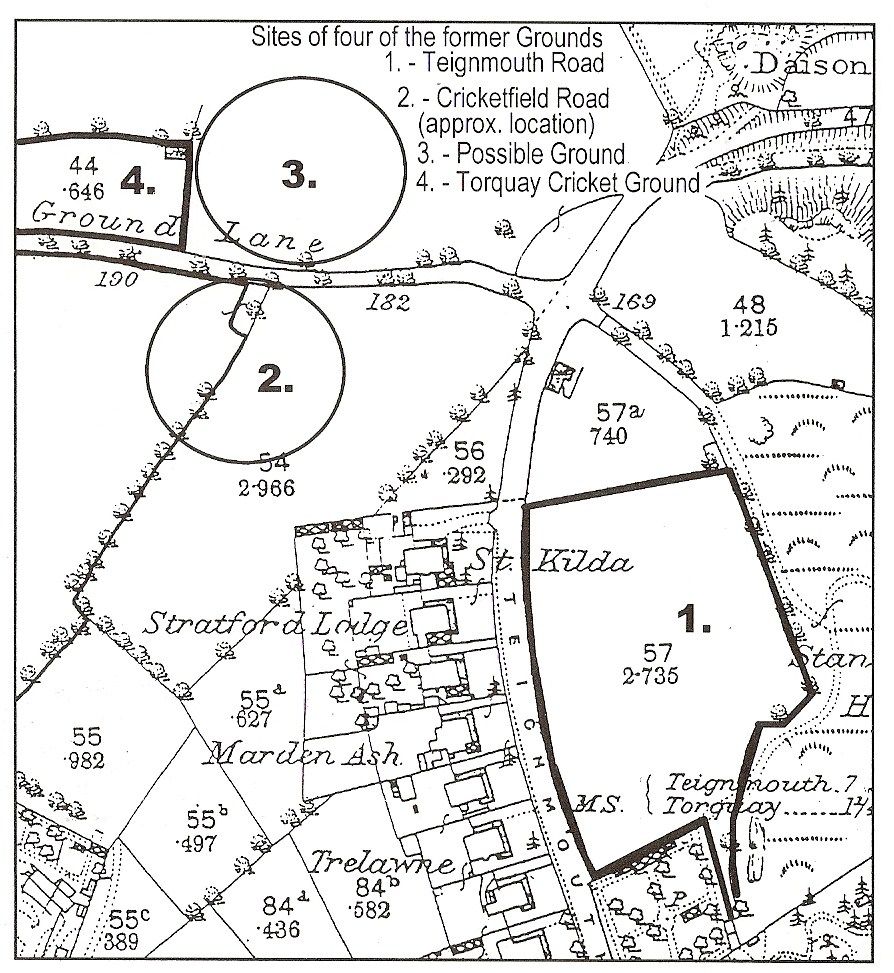 And this is from Iredale's 1890s map of Torquay. The locality is very much on the edge of things; almost in the sticks. The cricket club has been there since the 1850s; over the years there had been a number of big occasions featuring the stars of the game. John Pike's Torquay: the Place and the People tells us that there was a “fine thatched pavilion” which burned down in 1906. You trust the footballers weren’t responsible. 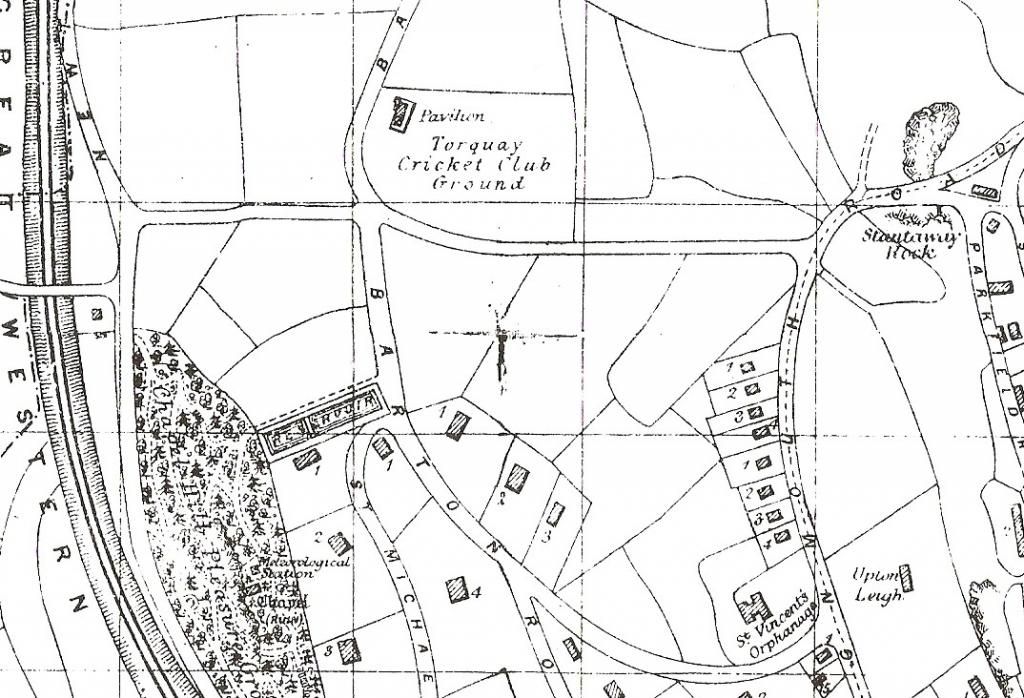
|
|
Deleted
Deleted Member
Posts: 0
|
Post by Deleted on Nov 28, 2014 20:38:52 GMT
A few more images from Iredale's town map featuring several sporting venues. The map does not extend as far northwards as the steeplechase course at Petitor. Here's the original golf course at Walls Hill which, I believe, was a nine-hole arrangement. Building a bigger course elsewhere became commercially viable during Edwardian times and we see Petitor opening in 1911. This wouldn't have been too long after the Torquay United and Ellacombe merger. I guess that represents consolidation. A hundred years ago, on the outbreak of the Great War, you'd have found football at Plainmoor; rugby at The Rec; golf at Petitor. 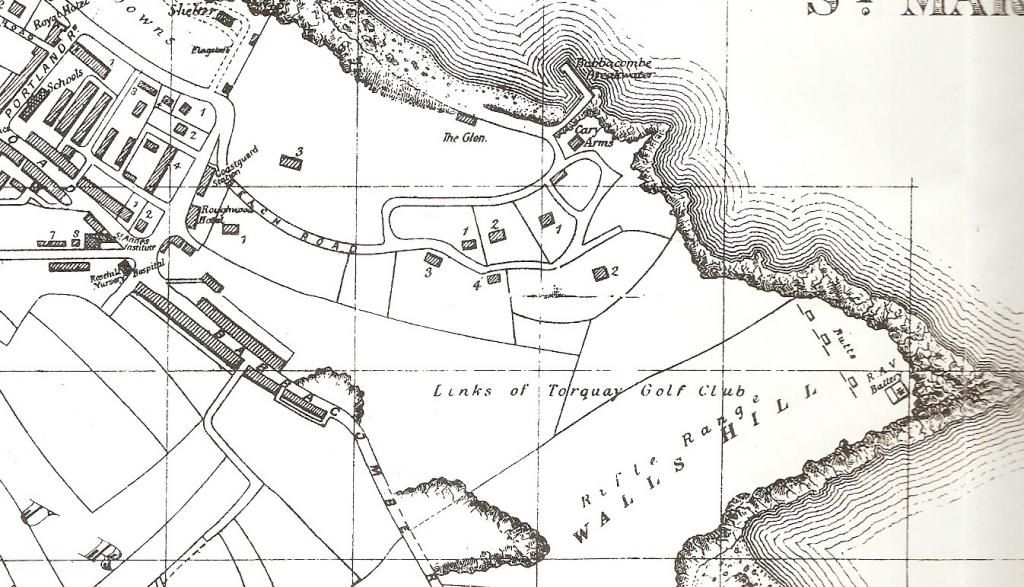 We've heard how Babbacombe FC were booted out of their Palk Arms ground to make way for the golfers. Imagine if that hadn't happened. Babbacombe could, quite possibly, be in the Western League (as, I'll concede, the town's second club) playing next door to a fully-appointed National Hunt racecourse. Newton Abbot, of course, would have been forced out of business because of the superior racing at Petitor. There'd be a Racecourse End (assuming the pitch was laid in that direction) and wonderful listed main stand at Babbacombe's marvellous old ground ("The Palk"). Torquay's golfers, you suppose, would be resigned to playing pitch-and-putt on Torre Abbey meadows. The tennis courts near Belgrave Road. These certainly don't appear out of place in that part of town in that era. I'm not sure if they are "protected" or have merely led a charmed life. They certainly remain an oasis in Belgravia: 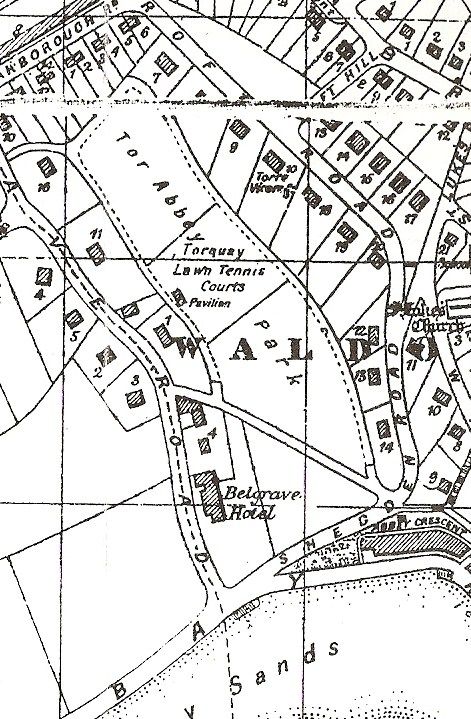 The Recreation Ground The Recreation Ground in pretty much its initial state and shape. Tics were at Plainmoor; the place was being used for other muscular Victorian sporting activity. Once the rugger had returned the next major change would be the arrival of Torquay Cricket Club in the 1920s. This involved an extension, some levelling of land and - in time - the building of a pavilion: 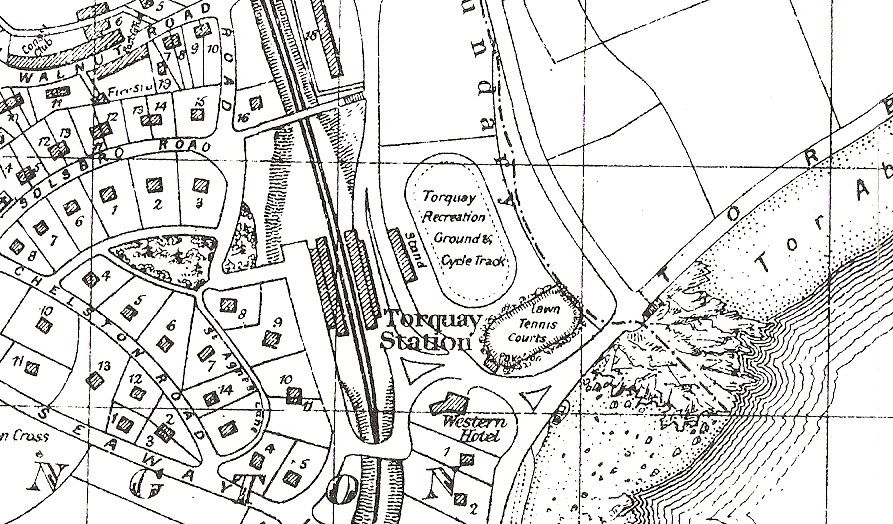 Upton Pleasure Grounds Upton Pleasure Grounds extending from the present town hall to Lymington Road coach station. I'm not sure what was the state of play here in 1904. Had Plainmoor disappeared under bricks and mortar could football still have developed in this area? It may have been exceedingly tight but just possible. The coach station site strikes me as the place where that Field of Dreams may have been created: 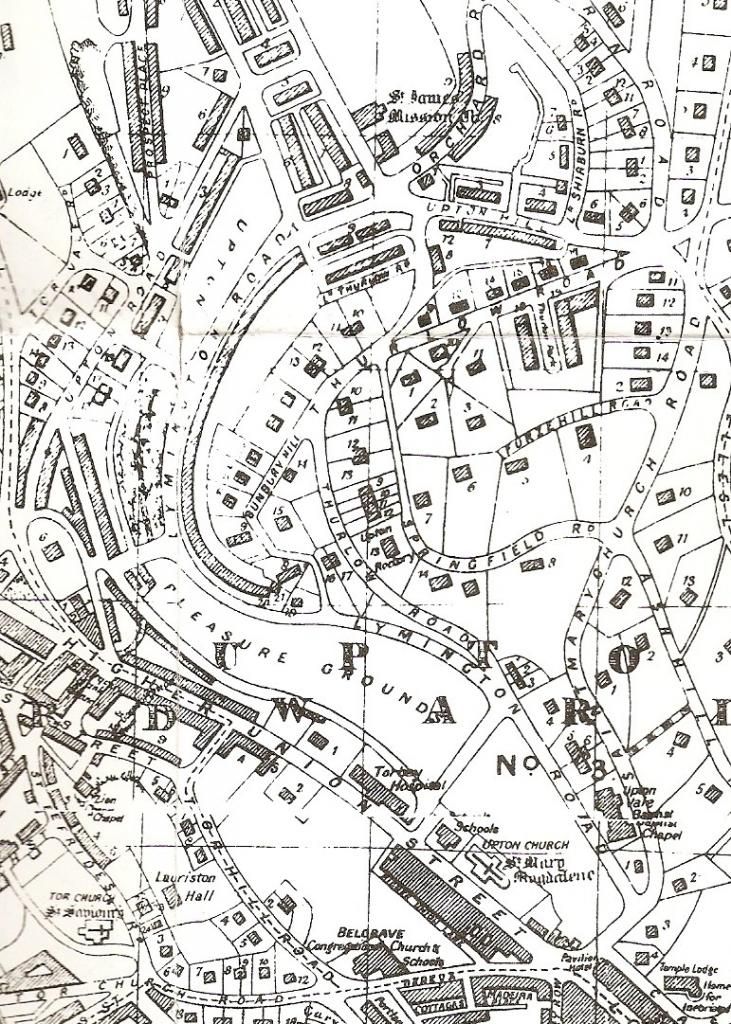 |
|
rjdgull
TFF member
 Admin
Admin
Posts: 12,227 
|
Post by rjdgull on Nov 29, 2014 9:24:07 GMT
Great thread  Quite interesting how demand for housing contributed to the various locations of football. Looking at the cricketfield road area, although a nice walk down to town, would have been a nice sub urban area above the terrace houses of Upton Road and Parkfield Road with good sized semis built at the Stantaway Hill and Parkhurst Road sites. The former must have been constructed very shortly after Torquay PC moved to the rec so wouldn't have been available on their return to the area. Parkhurst Road however is mainly 1920s built so not sure why that land wasn't available prior to the move back to Plainmoor? I take comfort that playing on the football pitch below the cricket ground during my school days in the 1980s was a former Torquay ground! The Cary Estate is still in existence today. Much of the housing around Plainmoor was constructed in the 30 years prior to the first world war. Marnham Road was built a bit later than the rest of Plainmoor in the 1900s. On the other side, Cary Park Road is later, built in the 1920s. I saw a house in this road still on the original Cary Estate 99 year lease dating from 1927 about 10-15 years ago! A substantial sum was needed to buy the Freehold on what was an UN-mortgageable property! |
|
Deleted
Deleted Member
Posts: 0
|
Post by Deleted on Nov 29, 2014 11:09:38 GMT
Much of the housing around Plainmoor was constructed in the 30 years prior to the first world war. Marnham Road was built a bit later than the rest of Plainmoor in the 1900s. On the other side, Cary Park Road is later, built in the 1920s. I saw a house in this road still on the original Cary Estate 99 year lease dating from 1927 about 10-15 years ago! A substantial sum was needed to buy the Freehold on what was an UN-mortgageable property! Interesting you say Cary Park Road is later; apparently after Plainmoor became established for football and schooling. Does this apply to Hingston Road as well? It may be that Plainmoor (post 1910) pretty much determined how the last piece of land - that side of Warbro' Road - would be filled. |
|
rjdgull
TFF member
 Admin
Admin
Posts: 12,227 
|
Post by rjdgull on Nov 29, 2014 13:44:45 GMT
Yes, I think the roads were built parallel from the older All Saints Road either side of WW1ish up to the ground / school but of course Windsor and Warbro Roads as known now we're already there to form the boundaries of that development.
|
|
Deleted
Deleted Member
Posts: 0
|
Post by Deleted on Nov 29, 2014 21:55:04 GMT
Floodlights were first used in November 1954 but these were only good enough for friendly matches. The first League game under much improved lights was in December 1960. I was down at Corbyn's Head before the match today and, as I usually do when I arrive in Torquay, I sought out the Plainmoor lights on the skyline. You can see them from opposite the Grand Hotel looming above Shedden Hill. They're invariably not quite where you expect them to be. The thought struck me that, given the first set of "proper" lights date from 1960, Plainmoor's floodlights have been a local landmark at least since I was five-years-old. Does anybody know if the earlier 1954 set were as prominent? 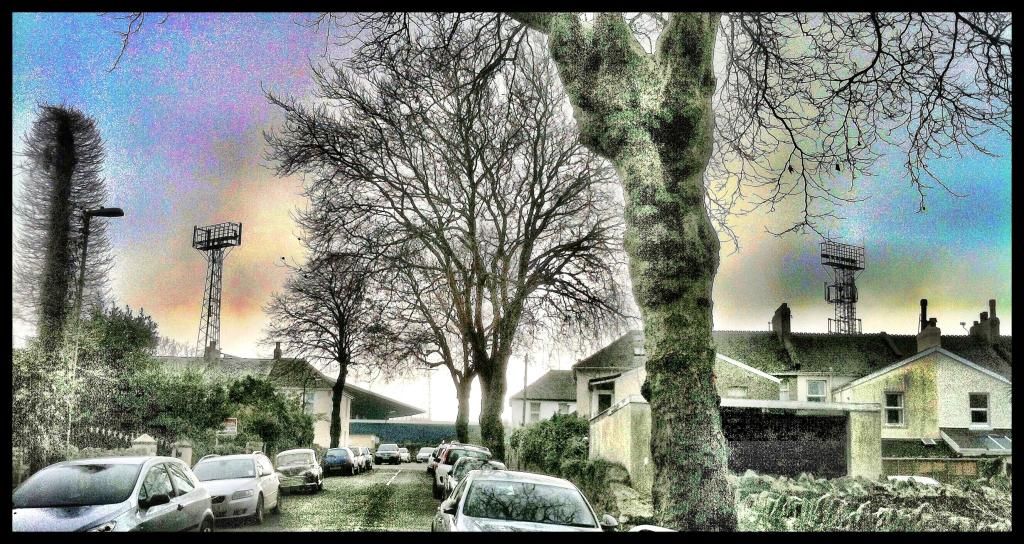 |
|
|
|
Mr_W
TFF member
 Cripes, Bully gets everywhere! Neighhhhh....
Cripes, Bully gets everywhere! Neighhhhh....
Posts: 1,016 
|
Post by Mr_W on Nov 30, 2014 6:53:59 GMT
.....wonderful pics there, Barty and a fab thread created by you and Jon - keep up the good work, my dear old bean, always a pleasure to read your thoughts etc - rgds - Mr_W......
|
|
Jon
Admin 
Posts: 6,912
|
Post by Jon on Nov 30, 2014 16:58:31 GMT
Parkhurst Road however is mainly 1920s built so not sure why that land wasn't available prior to the move back to Plainmoor? Looking at the map again, the houses built in 1906 or shortly after would have been on Cricketfield Road itself - between the junction with Parkhurst Road and the junction with Barton Road. Are those houses Edwardian? |
|
rjdgull
TFF member
 Admin
Admin
Posts: 12,227 
|
Post by rjdgull on Nov 30, 2014 20:52:33 GMT
Parkhurst Road however is mainly 1920s built so not sure why that land wasn't available prior to the move back to Plainmoor? Looking at the map again, the houses built in 1906 or shortly after would have been on Cricketfield Road itself - between the junction with Parkhurst Road and the junction with Barton Road. Are those houses Edwardian? Had a look on street view, the semis either side of Parkhurst Road with the single storey bay, to be fair, do look Edwardian. Will see if I confirm that.... |
|